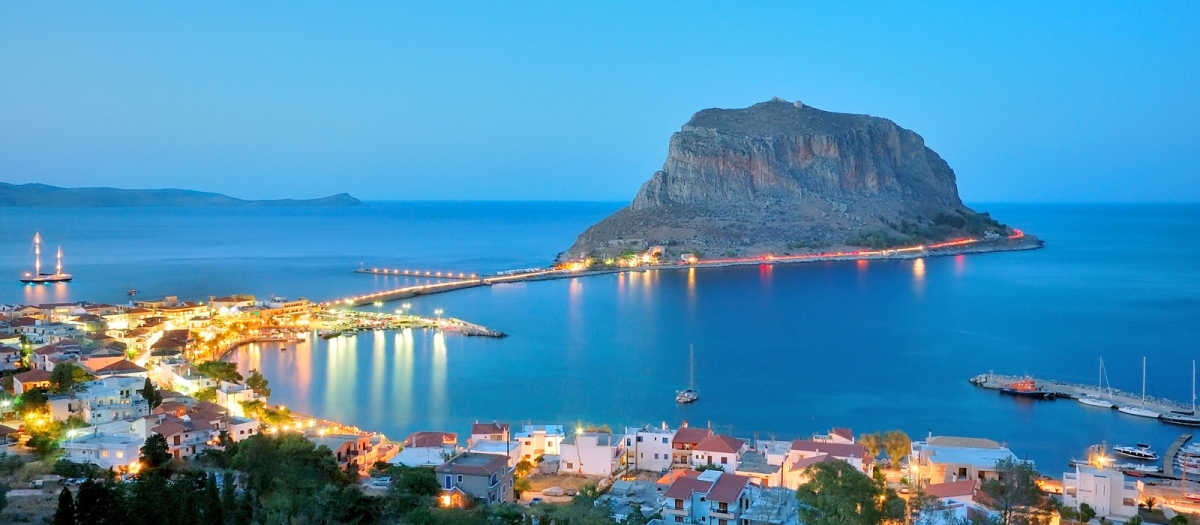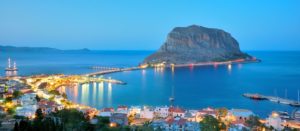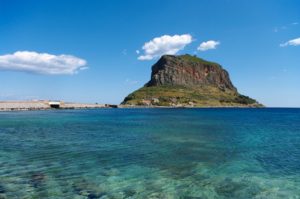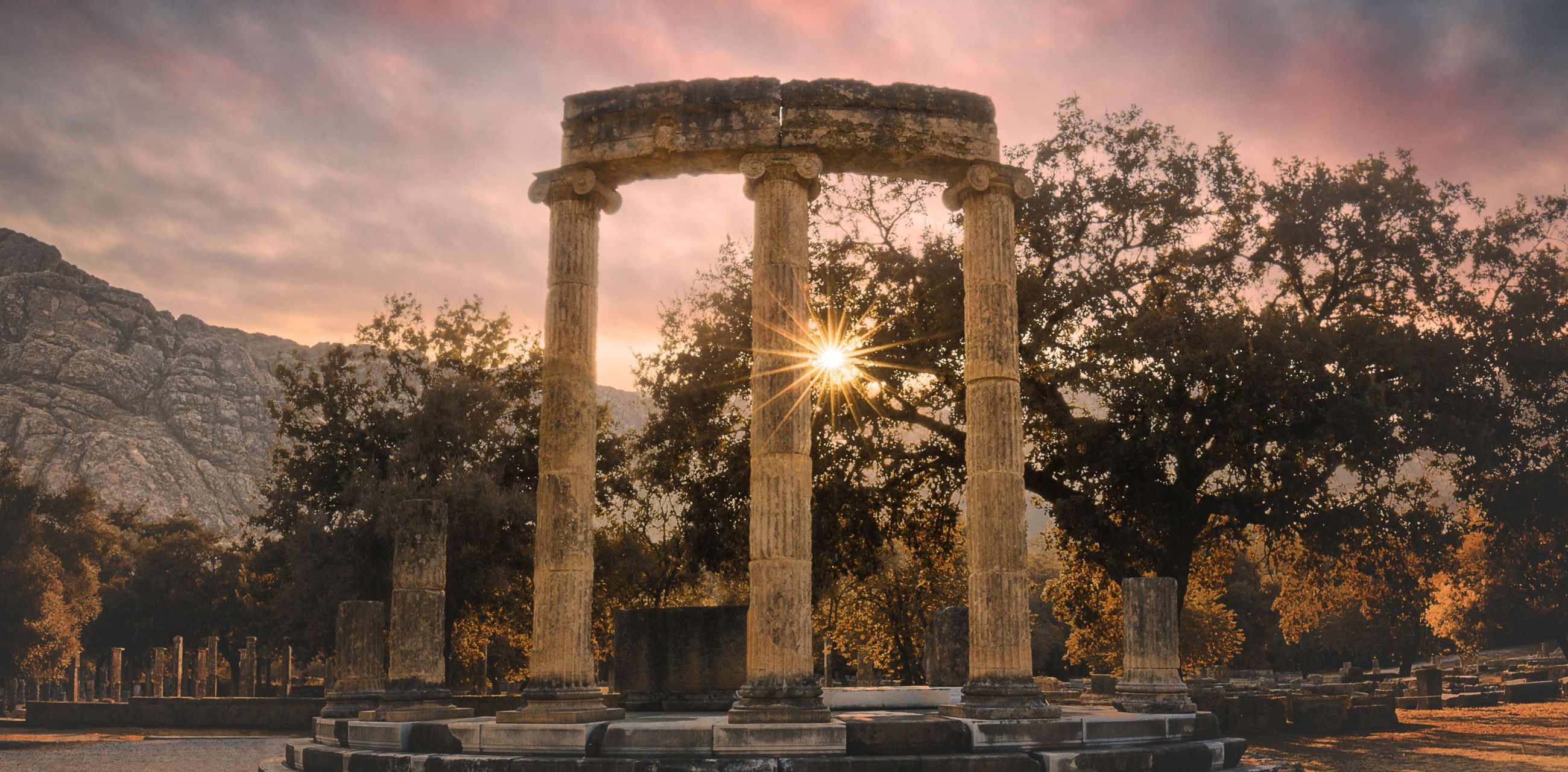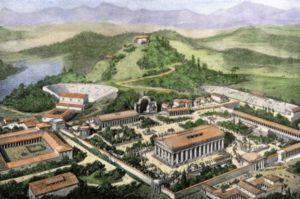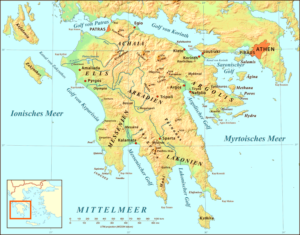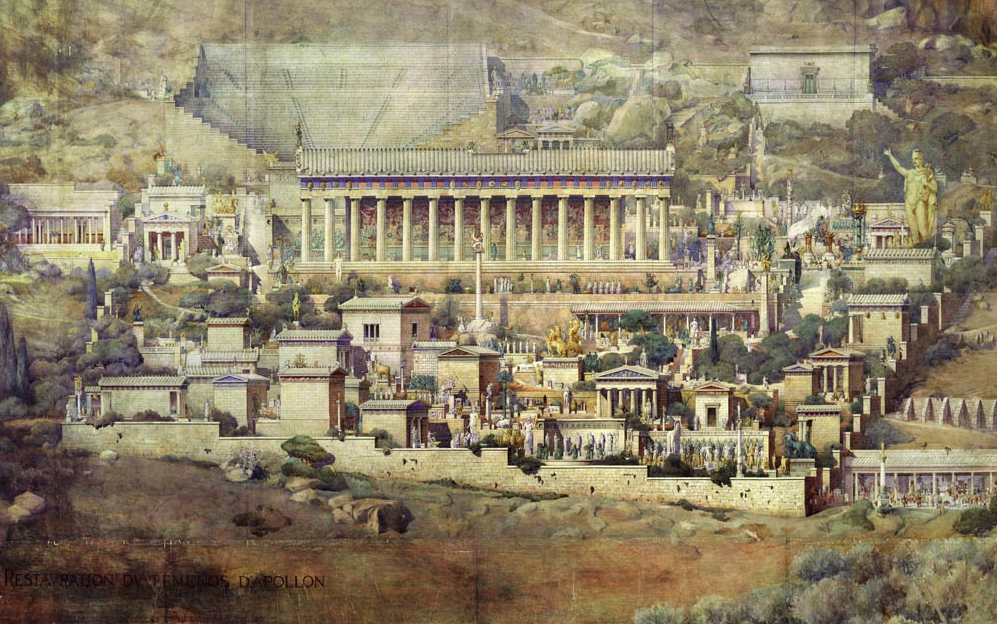[tabby title=”Operating days and prices”]
Corinth, famous for its canal (built-in 1893), is the city that inspired Paul’s most familiar letters in the bible addressed to the Corinthians.
To stand in the midst of the ruins of the church of Corinth and see the pillars, steps, and public worship place where Paul preached will enhance your understanding and love of I & II Corinthians. The ruins of this cultural centre are fascinating as you walk along the stone path that the Apostle walked.
See the Archaeological Museum, the Market Place, the Bema, and the Temples. The engineering skill and intellect of these people are evident in the water systems that still flow from ancient to modern-day. Though most of ancient Corinth has either disappeared over the years or been destroyed by Earthquakes there is still a temple to Apollo built in the 5th c. BC. The Peirene Spring is said to have been a woman transformed by the tears she shed for her son who was killed by the Goddess Artemis. It still supplies old Corinth with water. The archeologists you may see working are from the Athens’ American School of Classical studies.
This tour operates only between APRIL – OCTOBER on Mondays and Fridays.
PRICES: All travel agents, in Greece and worldwide, offer the same tour at different prices. We are sure that our price for this tour is not matched by any other company. The reason is that organizing tours throughout Greece since 1958 we have secured the best deals in all aspects of travel.
Our price, per adult is: 51.00 € p.p. + applicable entrance fees.
APPLICABLE ENTRANCE FEES:
APRIL – OCTOBER, E.U. Juniors <25 and E.U. students, are allowed free of charge.
APR – OCT, Juniors under 25 from other countries and E.U. seniors >65 pay 4.00 €
APRIL – OCTOBER everybody else pays 8.00 €
INCLUDED:
– Transportation by modern air-conditioned buses,
– the services of the professional tour guide, and
– the pickup/drop off (from the hotels in the list published in the footer)
HIGHLIGHTS
Small group tour
6-hours guided tour to Ancient Corinth
A religious tour led by an expert guide
Stop at the famous Corinth canal & enjoy breathtaking views
Visit Ancient Corinth with the temple of Apollo & its age-old streets
Pick-up/drop-off service is included from Athens central hotels
[tabby title=”Itinerary”]
For the Christians, Corinth is well-known from the First and Second letters of Saint Paul to the Corinthians in the New Testament. Corinth is also mentioned in the Book of Acts as part of the Apostle Paul’s missionary travels. Ancient Corinth was one of the largest and most important cities of Greece. The Romans demolished Ancient Corinth in 146 BC, built a new city in its place in 44 BC, and later made it the capital of Roman Greece.
Starting at 07.30 am the bus picks up clients from the central hotels in Athens (see the list in the footer), brings them to the terminal in the centre of Athens, and departs at +/- 08.30
The drive to Corinth offers a variety of landscape viewing the Saronic Gulf and its islands. You pass from the industrial city of Elefsis, home of the ancient Elefsinian Mysteries, the most important cult religion of antiquity before Christianity. An hour later we reach the Corinth Canal.(short stop). The 6,346 m long isthmus, is one of the 4 pre-20th century, man-made waterways on earth. The canal connects the Aegean Sea (East) with the Ionian Sea (West), today very popular for extreme sports (bungy jumping). The view from the bridge at the top of the canal is breathtaking.
The opening of the canal was a very old idea. At the western entrance a paved way on which the ancient Corinthians pulled the ships on greased tree trunks from the one side to the other can be seen. The canal started in 1881 and was finished and opened, only in 1893.
The town of ancient Corinth where St. Paul lived, worked, and preached for two years is 7km. from the canal, at the base of the hill of Acrocorinth. Acrocorinth was the Acropolis of Corinth and it rises about 600 m. (1800 ft). Ruins of a temple of Aphrodite, dominating the site, can be seen here.
Back in the ancient times Corinth was the capital of Roman Greece and one of the richest cities and this is quite evident by its remains. A huge agora (marketplace) and Apollo’s Temple (6th C.B.C). 7 of the 38 columns still stand. The ancient city of Corinth has been destroyed 3 times in its past and was rebuilt from scratch. The Romans seized, destroyed, and burned the city (146 BC) to the ground.
When Paul arrived in Corinth (51 AD) he arrived in a newly built city. The Corinthians collected a lot of money, by controlling the Corinth canal, and as a result of the wealth that they had, they were living a very immoral life.
You can see the remains of the theatre and the Roman Odeon, while among the ruins of the Roman Agora you can see the row of shops where Paul worked as a tent maker, together with Aquila and Priscilla, as well as the Bema, where Paul was judged by the Roman Governor when the Jews of Corinth accused him.
Here in Corinth Paul created one of the biggest Christian communities in Europe. Read about Paul’s life in Corinth on the left-hand side column of this page.
Corinth played a major role in the missionary work of Paul. Leaving Athens Paul visited Corinth, one of his beloved cities. He lived in Corinth for 18 months working as a tent maker and converting as many Jews and pagans as he could.
We will walk on the same paths that the Apostle of Nations walked and preached hundreds of years earlier. The Acts of the Apostles tell us that the Corinthian Jews turned against Paul. They dragged him to the court accusing him that he was illegally trying to persuade people to follow his preaching. A few weeks later he decided to leave Corinth. He sailed to Ephesus. He said goodbye to his friends and he left Corinth accompanied by Silas, Timothy, Aquila and Priscilla.
After exploring the museum and the site we proceed to the ancient port of Cechreae from where St. Paul sailed to return to Ephesus in 52 AD.
Apostle Paul is the patron saint of Corinth and the Corinthians built an impressive church in his honour. We will have the time to visit the Cathedral of St. Paul with the beautiful mosaic/mural depicting his vision.
Return to Athens +/- 14.00.
HIGHLIGHTS
-Archaeological Museum of ancient Corinth
-Temple of Apollo
-Agora / Marketplace
-Roman buildings
-The Roman Bema
-The Theatre and Odeon / Asklepieion
-Lechaion road
[tabby title=” History of Corinth”]
The tour guide will begin with the history of Corinth and its excavations and takes the visitors through the archaeological site from the Temple of Apollo to the Forum, the Fountain of Peirene, and more. Her lecture will cover the ancient monuments outside the fenced area of the site, including the Odeion, the Theatre, and the Asklepieion, and the various remains of ancient Corinth located within and outside the ancient Greek walls, including the Sanctuary of Demeter and Kore and the Lechaion Basilica.
The site of ancient Corinth was first inhabited in the Neolithic period (5000-3000 BC), and flourished as a major Greek city-state from the 8th c. BC until its destruction by the Romans in 146 BC.
Its commanding position on the Isthmus of Corinth, the narrow strip of land that separates the Peloponnese from northern Greece, was the primary basis of its importance. Corinth controlled the “diolkos”, the 6th-c. BC stone-paved roadway that connected the Saronic Gulf with the Gulf of Corinth. This overland route allowed ships, passengers and cargo to avoid the difficult and time-consuming trip around the southern end of the Peloponnese.
Being a leading naval power as well as a rich commercial city enabled ancient Corinth to establish colonies in Syracuse (on the island of Sicily) and on Corcyra (today Corfu). These colonies served as trading posts for the bronze works, textiles, and pottery that Corinth produced.
Beginning in 582 BC, in the spring of every second year the Isthmian Games were celebrated in honor of god Poseidon. The Doric Temple of Apollo, one of Corinth’s major landmarks, was constructed in 550 BC at the height of the city’s wealth.
Corinth was conquered by Philip II of Macedonia in 338 BC, but it was named the meeting place of Philip’s new Hellenic confederacy. Immediately after Philip was assassinated, Alexander the Great came to Corinth to meet with the confederacy, to confirm his leadership, and forestall any thoughts of rebellion. At the Isthmian Games of 336 BC, the Greeks chose Alexander the Great to lead them in the war against the Persians.
In 146 BC Corinth was literally destroyed by the Romans, but in 44 BC it was rebuilt by Julius Caesar and became the capital of “Roman Greece”. The city prospered more than ever before and may have had as many as 800,000 inhabitants by the time of Paul. The city, mostly populated by freedmen and Jews, was devoted to business and pleasure.
Paul visited Corinth in the 50s AD and later wrote two letters to the Christian community at Corinth (the books of 1 and 2 Corinthians in the New Testament). When Paul first visited the city (51 or 52 AD), Gallio, the brother of Seneca, was proconsul of Corinth.
Paul lived in Corinth for 18 months (Acts 18:1-18), working as a tent maker and converting as many Jews and pagans as he could. Here he first became acquainted with Aquila and Priscilla, who became his fellow-workers.
Although Paul intended to pass through Corinth a second time before he visited Macedonia, circumstances were such that he first went from Troe to Macedonia before stopping at Corinth for a “second benefit” (2 Corinthians 1:15). This time he stayed in Corinth for three months (Acts 20:3).
It was probably during this second visit in the spring of 58 that Paul wrote the Epistle to the Romans. Paul’s First Epistle to the Corinthians, written from Ephesus, reflects the difficulties of maintaining a Christian community in such a cosmopolitan city.
A canal through the isthmus of Corinth was begun under the emperor Nero in 67 AD. Wielding a gold shovel, Nero himself was first to break ground, but the canal was not completed. Up to the 12th century, ships were dragged on rollers across the isthmus.
In 267 AD, the invasion of the Herulians initiated the decline of the city. During Alaric’s invasion of Greece in 395–396, he destroyed Corinth and sold many of its citizens into slavery. Nevertheless, Corinth remained inhabited for many centuries through successive invasions, destructions and plagues.
After 1204, when Constantinople fell to the Fourth Crusade, Corinth was a prize sought by all. Corinth was captured by the Turks in 1458; the Knights of Malta won it in 1612; the Venetians took a turn from 1687 until 1715, when the Turks returned; and the city finally came into Greek hands in 1822.
In 1893 a 4-mile (6-km) Corinth canal was finally completed, providing an essential shipping route between the Ionian and Aegean seas. Like its ancient predecessor, modern Corinth is the center of commerce between northern and southern Greece. Today, it has a population of about 30,000.
Systematic archaeological excavations of the area, initiated by the American School of Classical Studies in 1896, are still continuing today and have brought to light the agora, temples, fountains, shops, porticoes, baths and various other monuments. The finds are exhibited in the on-site Archaeological Museum of Ancient Corinth.
[tabby title=”What to See at Corinth”]
The ruins of ancient Corinth, a short drive from the modern city of Corinth, are spread around the base of the rock of Acrocorinth, which forms a natural acropolis for the city. Most of the surviving buildings are Roman rather than Greek, dating from the city’s prosperous age after Caesar sacked and rebuilt much of the original Greek city. Much of the city has been toppled by recurring earthquakes over the centuries.
On the Acrocorinth itself are ruins of the Temple of Aphrodite, of which little remains. The Temple of Aphrodite had more than 1,000 sacred prostitutes at one time, exemplifying the ancient city’s reputation for luxury and vice. Also on Acrocorinth are the ruins of a stone minaret and ancient defensive walls.
The most notable ruin of ancient Corinth is the 6th-century BC Temple of Apollo, built on a hill overlooking the remains of the Roman marketplace (agora). Seven of the original 38 Doric columns still stand, and it is one of the oldest stone temples in Greece. The temple was still functioning in the time of Paul (50s AD) but was eventually destroyed by earthquakes.
Part of the foundation and a few pillars remain of the Temple of Octavia (known to scholars as ” Temple E”), dedicated to the sister of Emperor Augustus (27 BC-14 AD). The temple represents the imperial cult of Rome, which was spread throughout the empire.
A sacred spring is located along the northern edge of the forum—near Lechaion Road. The spring was above ground in the 5th century BC but later building activities covered it. Near the spring is a secret passage leading to a small shrine. The passage was probably used by the priests but it is unknown in exactly what capacity.
Within the Roman Forum is the Bema, the public platform where St. Paul had to plead his case when the Corinthians hauled him up in front of the Roman governor Gallio in 52 AD.
Significant ruins of the Peirene Fountain, the major source of water for Corinth, can still be seen today in the Roman Forum. It was an elaborate structure that served as a meeting place for Corinthians. Frescoes of swimming fish from a 2nd-century refurbishment can still be seen, and niche in the wall probably contained a statue. The fountain is named for Peirene, a woman who wept so hard when she lost her son that she finally dissolved into the spring that still flows here.
North of the Theater, inside the city wall, is the Asklepieion, the sanctuary of the god of healing with a small temple (4th century BC). It is set in a colonnaded courtyard with a series of dining rooms in a second courtyard. Terra-cotta votive offerings representing afflicted body parts (hands, legs, breasts, genitals, and so on) were found in the excavation of the Asklepieion, many of which are displayed at the museum.
The Archaeological Museum of Ancient Corinth contains a number of artifacts of religious interest, including inscriptions of Gallio and Erastus, both mentioned in the Book of Acts; a synagogue inscription, menorah reliefs, and votive offerings of terracotta body parts to Asklepios.
[tabby title=”Private tour”]
TOURS TO ACROCORINTH
On the summit, above the Ancient Corinth, you will see the Acropolis of Corinth, the Acrocorinth. It was successively used and fortified by many conquerors including Romans, Byzantines and Turks. On this tour, you will have the opportunity to visit the castle. Through its imposing entrance gates, you will enter the castle and you will explore it. You will also experience the spectacular panoramic views which will amaze you.
ACROCORINTH TOUR HIGHLIGHTS
-First, Second, Third Gates
-Peirene Spring
-Temple of Aphrodite – Views of Geraneia Mountain with the Blue lake and Temple of Hera.
-Acrocorinth Snack bar/ Restaurant with fabulous views.
Midday, enjoy a delicious traditional authentic lunch on a fabulous balcony overlooking the archaeological site… Gemelos’taverna!
[tabby title=”booking form”]
[tabbyending]
CLICK here and see ALL THE GUIDED TOURS that start from Athens. Detailed information on each tour is included.

